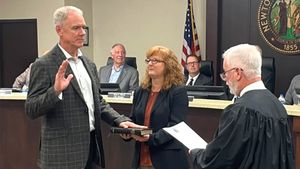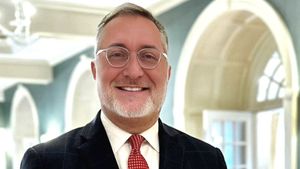Why the name change?
We write frequently about our commitments to following the science, tracking data, gathering user feedback, and responding to the community’s needs—and our name change honors those commitments. We want our program to reflect today’s science, as well as the terms most of our visitors use to tell their stories about HIV or to search for information about HIV and AIDS on our website.
As we prepare for this name change, we’ll share updates and feedback we receive. After the changeover, our program, which is funded through the Secretary’s Minority AIDS Initiative Fund, will automatically redirect users who search for “AIDS.gov” to the new URL (HIV.gov).
We look forward to sharing more with you soon! For more details about our name change, read below. And we look forward to your feedback.
What factors are driving the change?
For more than a year, we’ve been listening to how people talk about HIV and AIDS, and we asked our partners and users for their input on the name change. We’ve also been watching how the terms are used on other websites and social media, and we assessed how they’re used on our site. Here’s what we found:
Science is advancing: In the beginning of the epidemic, the term “AIDS” became implanted in the public’s mind because it was used in the popular press before researchers identified the cause of AIDS and an international committee of scientists named it the Human Immunodeficiency Virus (HIV).
Today, people with HIV who are diagnosed early, linked to care, start antiretroviral therapy (ART), and take it as prescribed, can achieve life-long viral suppression that prevents HIV infection from progressing to AIDS. Viral suppression improves health outcomes for people living with HIV (PLWH), reduces HIV-related deaths, and prevents transmission of the virus to others.
AIDS has not gone away. People in the United States and around the world still develop AIDS and die from its complications. But as our ability to treat HIV infection has improved again and again over the years, AIDS is no longer an expected outcome of having HIV. Today, stopping the progression of the disease before AIDS develops by suppressing the virus to very low or undetectable levels is the primary aim of HIV medical care. Effective ART means that almost everyone living with HIV can achieve viral suppression, including many of those who had been diagnosed with AIDS in the past.
There are other reasons for focusing now on HIV rather than AIDS. Since 2010, a string of major scientific advances have dramatically improved our ability to prevent HIV transmission. Key studies showed that early treatment of PLWH could reduce transmission of the virus to HIV-negative partners by 93 percent over extended follow-up [through TasP] (HPTN 052), and that taking a daily pill containing HIV drugs [PrEP] significantly lowered the risk of an HIV-negative person contracting the virus (iPrEx study, the TDF2 Study, and the Partners PrEP trial ).
Searches are changing: Today, twice the number of people who come to our website from internet searches use the term “HIV” rather than “AIDS.” In addition, the majority of the social media conversations we participate in focus on the term “#HIV.” Changing our name to HIV.gov will improve our ability to help our users find the information they need.
Stories are evolving: In the early days of the epidemic, the public often referred to “AIDS victims.” But many people living with AIDS pushed back against that [phrase] because they did not see themselves as “victims.” They asked to be called “people with AIDS,” and this marked the beginning of a movement by those with HIV to define themselves on their own terms.
Now many of the people living with HIV with whom we work across the nation use the term “HIV” more often than “AIDS” to discuss themselves and the wider HIV community.
We see this in the personal stories shared by those who are HIV-positive in our Positive Spin digital storytelling initiative and in our Black Voices blog series, as well as in other resources by and for the community.
What did our partners say?
Our partners tell us that the pending name change reflects the progress we’ve made over 35 years of the epidemic and reinforces that it’s now possible for individuals to live long and healthy lives with HIV.
Our partners also noted that the term “AIDS” continues to make it difficult to serve key populations at risk for/living with HIV infection. “A big reason youth from communities of color and the LGBT community don’t come into the healthcare system is because they experience more stigma associated with AIDS. Talking about HIV in its current state and that it’s not a death sentence helps people come into my clinic, get on treatment, and be able to live life. I think other physicians would also welcome the chance to get out of the AIDS mindset and help people live,” said Michelle Collins Ogle, at the Warren-Vance Community Health Center, Inc.
“So many people have worked so hard and fought for so long to get us to this place. I started doing this work in 1985 when the reality of living with HIV was so very different than it is today. I cannot tell you how happy I am about the progress that has been made, but our work is far from over,” said Dr. Richard Wolitski, director of the Health and Human Services Office of HIV/AIDS and Infectious Disease Policy. “Now people with HIV can live just as long as their HIV-negative peers. I’ve been living with HIV for more than 20 years, and I don’t expect to ever develop AIDS.”
Wolitski noted: “This change focuses all of us more clearly on ending HIV, whether that’s stopping transmission or preventing the destructive effects of HIV on the body. It represents all of us who are dedicated to stopping HIV transmission and improving HIV care, as well as those of us who are living with HIV, regardless of whether we have been diagnosed with AIDS. We will continue working to address the needs of all people who are at risk for, or living with, HIV. We understand that the experiences and needs of people living with AIDS can be different from those of other people living with HIV and that we all need to take this into account in the work that we do. Together we’ll continue to work toward our dream of seeing the end of this epidemic. It is within our grasp, but our work is not over yet.”
MIGUEL GOMEZ (pictured above), is the director of AIDS.gov, and senior communications advisor of the Office of HIV/AIDS and Infectious Disease Policy, U.S. Department of Health and Human Services. This piece previously ran on AIDS.gov.

















































































